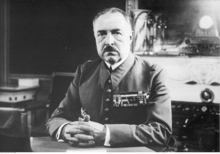Gaston Billotte
Gaston Henri Gustave Billotte (born February 10, 1875 in Sommeval , Département Aube , † May 23, 1940 in Ypres , Belgium ) was a French Général d'armée . He commanded the 1st Army Group during the Battle of France ( Western campaign ) and during the tank breakthrough near Sedan in mid-May 1940.
Life
Gaston Billotte was the son of a school principal whose family came from Bourgogne.
After leaving the Saint-Cyr Military School in 1896, he went to the marines. He later served in Tonkin and China , then returned to France and attended the École supérieure de guerre (doctorate 1907–1909). He returned to Tonkin as Chief de bataillon from 1911 to 1913 and then served in Morocco in the occupation corps there until 1915 . He is the father of Pierre Billotte (1906-1992), French general and politician.
First World War
In 1915 he was assigned to the Grand Quartier Général as Lieutenant-Colonel , where he became head of the department responsible for foreign theaters of war. In 1916 he was promoted to Colonel ( Colonel ) and appointed head of the Operations Department ( 3ème bureau ) of the General Staff ( Groupe de l'avant ). In 1918, he commanded an infantry regiment and suffered in the fighting around the Kemmelberg in West Flanders , a mustard gas poisoning .
Interwar period
After the war, between April 1919 and December 1920 he was a member of the French military mission in Poland during the Polish-Soviet War . In July 1920 he was promoted to the Général de brigade . From February to June 1921 he was commander of the 1st Infantry Brigade in Tunisia and commander of Tunis. He was then until November 1924 commander of the 2nd division in the League of Nations mandate for Syria and Lebanon . From 1925 to 1926 he took part in the Rif War in Morocco . After his promotion to Général de division in April 1927, he was assigned to the General Staff of the Colonial Forces. In December 1927 he took command of the 10th and in May 1929 of the 3rd Colonial Infantry Division, in 1930 of the French troops in French Indochina . After his return to France in 1933 he was promoted to Général d'armée and in November of that year a member of the Conseil supérieur de la Guerre, which he remained until the beginning of the Second World War. From 1936 to 1937 he was also chairman of the Comité consultatif de défense des colonies . On November 17, 1937, he was appointed military governor of Paris .
Second World War
After France entered the war in September 1939, he took over command of the 1st French Army Group, which was assembled on the Belgian border. In December, after the German victory over Poland , he wrote a memorandum to his superiors Maurice Gamelin and Alphonse Georges about the lessons to be learned from this German lightning campaign. The lack of field fortifications and anti-tank guns as well as the unfavorable terrain for the defender, which was decisive for the quick German victory over Poland, applies to Belgium to a similar extent. The numerical and technical superiority of the French armored weapon over the German one should also be regarded as deceptive.
At the beginning of the German campaign in the west , Billotte was responsible for the implementation of the Dyle-Breda plan by the 1st, 7th and 9th Army, which was subordinate to him, but which failed due to the rapid collapse of the Meuse front and the German breakthrough at Sedan . He then tried to build a new defensive front. On May 19, 1940, he took part in a conference in Ypres in which General Maxime Weygand , who had just taken command, tried to organize an offensive and cut off the rear parts of the broken German armored units. When Billote was driving back from this conference on the night of May 21st to 22nd, his car collided with a military truck in the village of Locre (Belgium, near Bailleul ). He was seriously injured, fell into a coma and died in hospital on May 23 (“Mort pour la France”). Billotte's successor was the previous Commander-in-Chief of the 1st Army, General Georges Blanchard .
Individual evidence
- ^ Archives départementales de l'Aube
- ↑ Biographies des députés de la IVe République: Pierre BILLOTTE
- ↑ La France accuse les maquilleurs de son histoire de Pierre Porthault, 1968, p. 264.
- ↑ III-10 Le cahier de Valentine BUTTIN (1894-1978) ( Memento of the original from April 10, 2015 in the Internet Archive ) Info: The archive link has been inserted automatically and has not yet been checked. Please check the original and archive link according to the instructions and then remove this notice.
| personal data | |
|---|---|
| SURNAME | Billotte, Gaston |
| ALTERNATIVE NAMES | Billotte, Gaston Henri Gustave (full name) |
| BRIEF DESCRIPTION | French general |
| DATE OF BIRTH | February 10, 1875 |
| PLACE OF BIRTH | Sommeval , Aube department |
| DATE OF DEATH | May 23, 1940 |
| Place of death | Ypres , Belgium |
